DSRP Theory: A Primer
Abstract
1. Introduction: DSRP Theory
- Distinction is defined as identity co-implying other ().
- System is defined as part co-implying whole ().
- Relationship is defined as action co-implying reaction ().
- Perspective is defined as point co-implying view ().
| “the ways is/is not , , and from determines and .” |
Since Cabrera’s first writings, we now have the benefit of over 20 years of hindsight on the possible start of a fourth wave (which is as long as the gap between the first and second waves, and twice as long as the gap between the second and third waves). During those years, we have seen considerable testing of Cabrera’s DSRP Theory, including: (1) a burgeoning amount of empirical evidence (at least as much as has been offered in the previous waves); (2) substantial private sector funding to develop tools for systems thinking; (3) substantial public funding for research; (4) a substantial peer review and publication history, sizeable citation histories, including several special issues dedicated to DSRP; (5) considerable public exposure and critique; (6) public adoption; (7) high attendance annual conferences; institutional recognition and support; and (9) as yet, few competitor theories (at least, none that have been explicated and communicated to the same degree).
Midgley, Francois and Schwarz—have made separate attempts to encapsulate the long history and vast terrain of knowledge-about-systems. Midgley acted as editor to the most complete review of systems thinking available today. Midgley’s four-volume collection, entitled Systems Thinking [18], includes ninety-seven papers that he and an International Advisory Board of “forty-seven distinguished writers from across the spectrum of the systems movement” (p5) thought were seminal… Francois assembled the two-volume International Encyclopedia of Systems and Cybernetics [19], which contains 3800 distinct systems concepts… Schwarz [20] developed a map entitled “Some Streams of Systemic Thought” with over 1000 nodes.
Empirical Findings of DSRP across the Disciplines
2. Research Methods
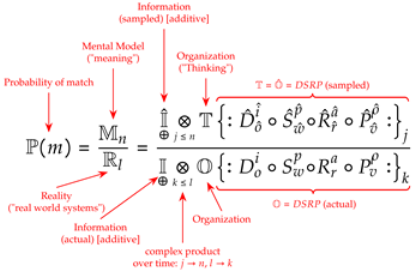
- 1.
- the applicable domains (reality (or real-world systems) and mental models);
- 2.
- the goal (increasing the probability. Regarding , the evidence that DSRP Theory increases this probability—what we call parallelism—is that we see DSRP in both material (empirical) complexity and cognitive complexity (see [6,7,10,11,12,13,14,15,16,17,164]). Note that (a) the fraction, , is not the same as the probability that this fraction is closer to 1; (b) the closer it gets to 1 the more accurate the mental model; (c) evidence for the validity of a specific mental model (X) is not the same as evidence for this increased probability. These are sometimes confused as a match between mental models and reality (a.k.a., parallelism);
- 3.
- the universal structures and structural rules of organization (i.e., DSRP);
- 4.
- the dynamical rules (co-implication and simultaneity);
- 5.
- the fundamental action (organization, or );
- 6.
- the fundamental element being acted upon or organized (i.e., information, or );
- 7.
- the relationship between information and organization over time (complex product, or ⊗);
- 8.
- the basis on which to make structural predictions that aid knowledge creation, innovation, invention and discovery.
3. Results In Practice
4. Discussion
- (1)
- that if A (i.e., anything) exists then DSRP structures must also exist;
- (2)
- that information variables follow the same rules and thus simultaneously act as any of the various patterns and elements of DSRP;
- (3)
- that each pattern requires all of the patterns (and therefore elements) as necessary and sufficient in order to exist, where each pattern (D, S, R, and P) consists of exchangeable i/o and /v and each is relational and systemic.
- every edge is a (relational) node. [Pay attention, this one rule alone leads to networks that are rarely explicated but universal in nature.];
- every node is a sub-network;
- every node is co-defined by all the other nodes;
- every node has a point of view (which effects its behavior).
 . Additionally, we can predict that every node has a unique perspective (indicated by blue nodes) on its locality. Even meta-systems such as those shown in light red and blue exist across the larger system and even those systems can be related by distinguished and systematized nodes.
. Additionally, we can predict that every node has a unique perspective (indicated by blue nodes) on its locality. Even meta-systems such as those shown in light red and blue exist across the larger system and even those systems can be related by distinguished and systematized nodes.- 1.
- What things are we seeing/not seeing?
- 2.
- How are these things grouped?
- 3.
- How are these things related?
- 4.
- From what or whose perspective?
DSRP is a fractal, self-similar repeating structure. It applies a simple ruleset across scales from the tiniest to the largest phenomena. If one thinks of an identity as a simple line segment, D, S, R, and P provide additional rules of transformation to that line segment, similar to the Koch snowflake, thus space filling as if it was an area. This is illustrated in the idea that four also comes from the fractal space filling and scaling laws. Where does the “magical” number four come from? West [167] explains,“A crinkly enough line that is space filling can scale as if it’s an area. Its fractality effectively endows it with an additional dimension. Its conventional Euclidian dimension…still has the value 1, indicating that it’s a line, but its fractal dimension is 2, indicating that it’s maximally fractal and scaling as if it were an area. In similar fashion an area, if crinkly enough, can behave as if it’s a volume, thereby gaining an effective extra dimension: its Euclidian dimension is 2, indicating it’s an area, but it’s fractal dimension is 3”.
This, perhaps more than any other explanation, explains why there are four patterns and not 5, or 9.2, or 37, etc.). In nature, the number four appears with spooky regularity.This additional dimension…leads to organisms’ functioning as if they are operating in four dimensions. This is the geometric origin of the quarter-power law. Thus, instead of scaling with classic 1/3 exponents, as would be the case if they were smooth nonfractal Euclidian objects, they scale with 1/4 exponents. Although living things occupy a three-dimensional space, their internal physiology and anatomy operate as if they were four-dimensional.(p. 153)
5. Conclusions
Author Contributions
Funding
Institutional Review Board Statement
Data Availability Statement
Conflicts of Interest
Abbreviations
| DSRP | DSRP Theory (Distinctions, Systems, Relationships, Perspectives) |
| D | identity–other Distinctions |
| S | part–whole Systems |
| R | action–reaction Relationships |
| P | point–view Perspectives |
| ST | Systems Thinking |
| STMI | Systems Thinking and Metacognition Inventory |
| RDS | Relate-Distinguish-Systematize Jig |
References
- Cabrera, D.; Cabrera, L.; Lobdell, C. Systems Thinking. J. Eval. Program Plan. 2008, 31, 299–310. [Google Scholar] [CrossRef] [PubMed]
- Cabrera, D.; Cabrera, L. Complexity and Systems Thinking Models in Education: Applications for Leaders. In Learning, Design, and Technology: An International Compendium of Theory, Research, Practice, and Policy; Spector, M.J., Lockee, B.B., Childress, M.D., Eds.; Springer International Publishing: Cham, Switzerland, 2019; pp. 1–29. [Google Scholar]
- Cabrera, D.; Cabrera, L. What Is Systems Thinking? In Learning, Design, and Technology: An International Compendium of Theory, Research, Practice, and Policy; Spector, M.J., Lockee, B.B., Childress, M.D., Eds.; Springer International Publishing: Cham, Switzerland, 2019; pp. 1–28. [Google Scholar]
- Cabrera, L.; Cabrera, D. The Simple Rules of Complex Networks: Heuristics for Structural Predictions. In The Routledge Handbook for Systems Thinking; Cabrera, L., Cabrera, D., Midgley, G., Eds.; Routledge Press: London, UK, 2022. [Google Scholar]
- Cabrera, D.; Cabrera, L. Distinctions, Systems, Relationships, and Perspectives (DSRP): A Theory of Thinking and of Things. J. Eval. Program Plan. 2008, 31, 311–317. [Google Scholar] [CrossRef] [PubMed]
- Cabrera, D. Systems Thinking; Cornell University: Ithaca, NY, USA, 2006. [Google Scholar]
- Cabrera, D.; Cabrera, L.; Midgley, G. (Eds.) The Four Waves of Systems Thinking. In The Routledge Handbook for Systems Thinking; Routledge Press: London, UK, 2021. [Google Scholar]
- Cabrera, D. Scientific Journal of Derek Cabrera. 1997. Available online: https://tinyurl.com/d2kut8hw (accessed on 1 December 2021).
- Cabrera, D.A. Knowledge Age Operating System: Four Principles of Organizational Design; Project N Press: Loveland, CO, USA, 2000. [Google Scholar]
- Cabrera, D.; Cabrera, L.; Cabrera, E. Perspectives Organize Information in Mind and Nature: Empirical Findings of Point-View Perspective (P) in Cognitive and Material Complexity. Systems, 2022; under process. [Google Scholar]
- Cabrera, D.; Cabrera, L.; Cabrera, E. Distinctions Organize Information in Mind and Nature: Empirical Findings of Identity-Other Distinctions (D) in Cognitive and Material Complexity. Systems, 2022; under process. [Google Scholar]
- Cabrera, D.; Cabrera, L.; Cabrera, E. Relationships Organize Information in Mind and Nature: Empirical Findings of Action-Reaction Relationships (R) in Cognitive and Material Complexity. Systems, 2022; under process. [Google Scholar]
- Cabrera, D.; Cabrera, L.; Cabrera, E. Systems Organize Information in Mind and Nature: Empirical Findings of Part-Whole Systems (S) in Cognitive and Material Complexity. Systems, 2022; under process. [Google Scholar]
- Cabrera, D.; Cabrera, L.; Cabrera, E.; Hernandez, O.; Sukhbaatar, U.; Kand Benitez Collante, A.E.; Lemaiyan, E.; Warugongo, N.; Sekyere, A.; Silas, D.; et al. The Origin of Ideas: Empirical Studies in Cognitive Complexity; Odyssean Press: Ithaca, NY, USA, 2022. [Google Scholar]
- Cabrera, D.; Cabrera, L.; Midgley, G. (Eds.) Routledge Handbook of Systems Thinking; Routledge: London, UK, 2022. [Google Scholar]
- Cabrera, D.; Cabrera, L.; Cabrera, E. A Literature Review of the Universal Patterns and Atomic Elements of Complex Cognition. In Routledge Handbook of Systems Thinking; Cabrera, D., Cabrera, L., Midgley, G., Eds.; Routledge: Ithaca, NY, USA, 2022. [Google Scholar]
- Cabrera, L.; Sokolow, J.; Cabrera, D. Developing and Validating a Measurement of Systems Thinking: The Systems Thinking and Metacognitive Inventory (STMI). In The Routledge Handbook for Systems Thinking; Cabrera, L., Cabrera, D., Midgley, G., Eds.; Routledge Press: London, UK, 2022. [Google Scholar]
- Midgley, G. Systems Thinking. Volume 1: General Systems Theory, Cybernetics and Complexity; Sage Publications Ltd.: London, UK, 2002. [Google Scholar]
- François, C. International Encyclopedia of Systems and Cybernetics; Walter de Gruyter: Berlin, Germany, 2011. [Google Scholar]
- Schwarz, E.; Durant, W. Some Streams of Systemic Thought; International Institute for General Systems Studies: Slippery Rock, PA, USA, 2001. [Google Scholar]
- Jackson, M.C.; Keys, P. Towards a System of Systems Methodologies. J. Oper. Res. Soc. 1984, 35, 473–486. [Google Scholar] [CrossRef]
- Jackson, M.C. Critical Systems Thinking and the Management of Complexity, 1st ed.; Wiley: Hoboken, NJ, USA, 2019. [Google Scholar]
- Spencer-Brown, G. Laws of Form; Allen & Unwin: London, UK, 1969. [Google Scholar]
- Krauss, L. Why Is There Something Instead of Nothing? Simon and Schuster: New York, NY, USA, 2012. [Google Scholar]
- Euler, L. Solutio problematis ad geometriam situs pertinentis. Comment. Acad. Sci. Petrop. 1735, 8, 128–140. [Google Scholar]
- Kolata, G. Studying Learning in the Womb. Science 1984, 225, 302–303. [Google Scholar] [CrossRef] [PubMed][Green Version]
- Partanen, E.; Kujala, T.; Näätänen, R.; Liitola, A.; Sambeth, A.; Huotilainen, M. Learning-induced neural plasticity of speech processing before birth. Proc. Natl. Acad. Sci. USA 2013, 110, 15145–15150. [Google Scholar] [CrossRef]
- Quinn, P.C.; Brown, C.R.; Streppa, M.L. Perceptual Organization of Complex Visual Configurations by Young Infants. Infant Behav. Dev. 1997, 20, 35–46. [Google Scholar] [CrossRef]
- Newman, R.S.; Jusczyk, P.W. The Cocktail Party Effect in Infants. Percept Psychophys 1996, 58, 1145–1156. [Google Scholar] [CrossRef]
- Gauthier, I.; Tarr, M.J. Becoming a “Greeble” expert: Exploring mechanisms for face recognition. Vis. Res. 1997, 37, 1673–1682. [Google Scholar] [CrossRef]
- Aubin, T.; Jouventin, P. Cocktail-party effect in king penguin colonies. Proc. R. Soc. Lond. Ser. B-Biol. Sci. 1998, 265, 1665–1673. [Google Scholar] [CrossRef]
- Fry, S.N.; Wehner, R. Honey bees store landmarks in an egocentric frame of reference. J. Comp. Physiol. A-Neuroethol. Sens. Neural Behav. Physiol. 2002, 187, 1009–1016. [Google Scholar] [CrossRef] [PubMed]
- Badre, D. Cognitive control, hierarchy, and the rostro-caudal organization of the frontal lobes. Trends Cogn. Sci. 2008, 12, 193–200. [Google Scholar] [CrossRef] [PubMed]
- Bukach, C.M.; Gauthier, I.; Tarr, M.J.; Kadlec, H.; Barth, S.; Ryan, E.; Turpin, J.; Bub, D.N. Does acquisition of Greeble expertise in prosopagnosia rule out a domain-general deficit? Neuropsychologia 2012, 50, 289–304. [Google Scholar] [CrossRef]
- Drews, G. Contributions of Theodor Wilhelm Engelmann on Phototaxis, Chemotaxis, and Photosynthesis. Photosynth. Res. 2005, 83, 25–34. [Google Scholar] [CrossRef] [PubMed]
- Sengupta, A.; Kruppa, T.; Löwen, H. Chemotactic Predator-Prey Dynamics. arXiv 2010, arXiv:1009.5521. [Google Scholar] [CrossRef] [PubMed]
- Berleman, J.E.; Kirby, J.R. Deciphering the hunting Strategy of a Bacterial Wolfpack. FEMS Microbiol. Rev. 2009, 33, 942–957. [Google Scholar] [CrossRef] [PubMed]
- Pradel, E.; Zhang, Y.; Pujol, N.; Matsuyama, T.; Bargmann, C.I.; Ewbank, J.J. Detection and Avoidance of a Natural Product from the Pathogenic Bacterium Serratia Marcescens by Caenorhabditis Elegans. Proc. Natl. Acad. Sci. USA 2007, 104, 2295–2300. [Google Scholar] [CrossRef]
- Rajalingham, R.; DiCarlo, J.J. Reversible Inactivation of Different Millimeter-Scale Regions of Primate IT Results in Different Patterns of Core Object Recognition Deficits. Neuron 2019, 102, 493–505. [Google Scholar] [CrossRef]
- Clark, T. National Boundaries, Border Zones, and Marketing Strategy: A Conceptual Framework and Theoretical Model of Secondary Boundary Effects. J. Mark. 1994, 58, 67–80. [Google Scholar] [CrossRef]
- Coye, D. The Sneakers/Tennis Shoes Boundary. Am. Speech 1986, 61, 366–369. [Google Scholar] [CrossRef]
- Powers, E.; Cabrera, L.; Cabrera, D. No Word Is an Island: Distinguishing “Nerd” and “Geek”. In Cognitive Case Study; Cornell University Press: Ithaca, NY, USA, 2016. [Google Scholar]
- Cabrera, D.; Cabrera, L. Systems Thinking Made Simple: New Hope for Solving Wicked Problems in a Complex World; Odyssean Press: Ithaca, NY, USA, 2015. [Google Scholar]
- Peterson, M.A.; Skow-Grant, E. Memory and Learning in Figure–Ground Perception; Psychology of Learning and Motivation; Academic Press: Cambridge, MA, USA, 2003; pp. 1–35. [Google Scholar] [CrossRef]
- Abdullah, M.H.; Klypin, A.; Wilson, G. Cosmological Constraints on Ω m and σ 8 from Cluster Abundances Using the GalWCat19 Optical-spectroscopic SDSS Catalog. ApJ 2020, 901, 90. [Google Scholar] [CrossRef]
- De Luca Picione, R.; Valsiner, J. Psychological Functions of Semiotic Borders in Sense-Making: Liminality of Narrative Processes. Eur. J. Psychol. Assess. 2017, 13, 532–547. [Google Scholar] [CrossRef] [PubMed]
- Glanville, R. The Self and the Other: The Purpose of Distinction. In “Cybernetics and Systems ’90” the Proceedings of the European Meeting on Cybernetics and Systems Research; Trappl, R., Ed.; World Scientific: Singapore, 1999. [Google Scholar]
- Durand, R.; Calori, R. Sameness, Otherness? Enriching Organizational Change Theories with Philosophical Considerations on the Same and the Other. AMRO 2006, 31, 93–114. [Google Scholar] [CrossRef]
- Gillette, J.M. Boundary Lines of Social Phenomena. Am. J. Sociol. 1925, 30, 585–593. [Google Scholar] [CrossRef]
- Tajfel, H.; Wilkes, A.L. Classification and quantitative judgement. Br. J. Psychol. 1963, 54, 101–114. [Google Scholar] [CrossRef]
- Davies, C. Sexual Taboos and Social Boundaries. Am. J. Sociol. 1982, 87, 1032–1063. [Google Scholar] [CrossRef]
- Langer, E.J.; Bashner, R.S.; Chanowitz, B. Decreasing Prejudice by Increasing Discrimination. J. Personal. Soc. Psychol. 1985, 49, 113–120. [Google Scholar] [CrossRef]
- Perdue, C.W.; Dovidio, J.F.; Gurtman, M.B.; Tyler, R.B. Us and Them: Social Categorization and the Process of Intergroup Bias. J. Personal. Soc. Psychol. 1990, 59, 475–486. [Google Scholar] [CrossRef]
- Leudar, I.; Marsland, V. On membership categorization: ’us’, ’them’ and ’doing violence’ in political discourse. Discourse Soc. 2004, 15, 243–266. [Google Scholar] [CrossRef]
- Young, J. On Insiders (Emic) and Outsiders (Etic): Views of Self, and Othering. Syst. Pract. Action Res. 2005, 18, 151–162. [Google Scholar] [CrossRef]
- Midgley, G.; Pinzón, L.A. Systemic mediation: Moral reasoning and boundaries of concern: Systemic mediation. Syst. Res. Behav. Sci. 2013, 30, 607–632. [Google Scholar] [CrossRef]
- Bentley, S.V.; Greenaway, K.H.; Haslam, S.A. Cognition in context: Social inclusion attenuates the psychological boundary between self and other. J. Exp. Soc. Psychol. 2017, 73, 42–49. [Google Scholar] [CrossRef]
- King, S.L.; Connor, R.C.; Krützen, M.; Allen, S.J. Cooperation-based concept formation in male bottlenose dolphins. Nat. Commun. 2021, 12, 2373. [Google Scholar] [CrossRef] [PubMed]
- Stafstrom, J.A.; Menda, G.; Nitzany, E.I.; Hebets, E.A.; Hoy, R.R. Ogre-Faced, Net-Casting Spiders Use Auditory Cues to Detect Airborne Prey. Curr. Biol. 2020, 30, 5033–5039.e3. [Google Scholar] [CrossRef] [PubMed]
- Rubin, N. Figure and ground in the brain. Nat. Neurosci. 2001, 4, 857–858. [Google Scholar] [CrossRef]
- Baylis, G.C.; Driver, J. Shape-coding in IT cells generalizes over contrast and mirror reversal, but not figure-ground reversal. Nat. Neurosci. 2001, 4, 937–942. [Google Scholar] [CrossRef]
- Bateson, G. Form Substance and Difference; Etc. 2015, Volume 72, pp. 90–104. Available online: http://www.jstor.org/stable/24761998 (accessed on 1 December 2021).
- Darwin, C. On the Origin of Species: By Means of Natural Selection, or the Preservation of Favoured Races in the Struggle for Life; John Murray: London, UK, 1859. [Google Scholar]
- Bertalanffy. The History and Status of General Systems Theory. Acad. Manag. J. 1972, 15, 407–426. [Google Scholar] [CrossRef]
- Rittel, H.W.J.; Webber, M.M. Dilemmas in a General Theory of Planning. Policy Sci. 1973, 4, 155–169. [Google Scholar] [CrossRef]
- Marchal, J.H. On the Concept of a System. Philos. Sci. 1975, 42, 448–468. [Google Scholar] [CrossRef]
- Goguen, J.A.; Varela, F.J. Systems And Distinctions: Duality And Complementarity. Int. J. Gen. Syst. 1979, 5, 31–43. [Google Scholar] [CrossRef]
- Ivan, M.; Kondo, K.; Yang, H.; Kim, W.; Valiando, J.; Ohh, M.; Salic, A.; Asara, J.M.; Lane, W.S.; Kaelin, W.G., Jr. HIFa Targeted for VHL-Mediated Destruction by Proline Hydroxylation: Implications for O Sensing. Science 2001, 292, 464–468. [Google Scholar] [CrossRef] [PubMed]
- Chen, P.; Fan, D.; Zhang, Y.; Selloni, A.; Carter, E.A.; Arnold, C.B.; Dankworth, D.C.; Rucker, S.P.; Chelikowsky, J.R.; Yao, N. Breaking a dative bond with mechanical forces. Nat. Commun. 2021, 12, 5635. [Google Scholar] [CrossRef] [PubMed]
- Wadhams, G.H.; Armitage, J.P. Making Sense of It All: Bacterial Chemotaxis. Nat. Rev. Mol. Cell Biol. 2004, 5, 1024–1037. [Google Scholar] [CrossRef]
- Janetopoulos, C.; Firtel, R.A. Directional Sensing during Chemotaxis. FEBS Lett. 2008, 582, 2075–2085. [Google Scholar] [CrossRef]
- Ikeya, N.; Woodward, J.R. Cellular autofluorescence is magnetic field sensitive. Proc. Natl. Acad. Sci. USA 2021, 118, e2018043118. [Google Scholar] [CrossRef]
- Förster, D.; Helmbrecht, T.O.; Mearns, D.S.; Jordan, L.; Mokayes, N.; Baier, H. Retinotectal circuitry of larval zebrafish is adapted to detection and pursuit of prey. Elife 2020, 9, e58596. [Google Scholar] [CrossRef]
- De Corte, B.J.; Navarro, V.M.; Wasserman, E.A. Non-cortical magnitude coding of space and time by pigeons. Curr. Biol. 2017, 27, R1264–R1265. [Google Scholar] [CrossRef] [PubMed]
- Schnell, A.K.; Loconsole, M.; Garcia-Pelegrin, E.; Wilkins, C.; Clayton, N.S. Jays are sensitive to cognitive illusions. R. Soc. Open Sci. 2021, 8, 202358. [Google Scholar] [CrossRef]
- Giannoni-Guzmán, M.A.; Rivera, E.; Aleman-Rios, J.; Melendez Moreno, A.M.; Ramos, M.P.; Pérez-Claudio, E.; Loubriel, D.; Moore, D.; Giray, T.; Agosto-Rivera, J.L. The Role of Colony Temperature in the Entrainment of Circadian Rhythms of Honey Bee Foragers. Ann. Entomol. Soc. Am. 2021, 114, 596–605. [Google Scholar] [CrossRef] [PubMed]
- Mareschal, D.; Quinn, P.C. Categorization in Infancy. Trends Cogn. Sci. 2001, 5, 443–450. [Google Scholar] [CrossRef]
- Ashby, F.G.; Ell, S.W.; Waldron, E.M. Procedural Learning in Perceptual Categorization. Mem. Cogn. 2003, 31, 1114–1125. [Google Scholar] [CrossRef] [PubMed]
- Sloutsky, V.M. The role of similarity in the development of categorization. Trends Cogn. Sci. 2003, 7, 246–251. [Google Scholar] [CrossRef]
- Lewis, M.; Balamurugan, A.; Zheng, B.; Lupyan, G. Characterizing Variability in Shared Meaning through Millions of Sketches. In Proceedings of the Annual Meeting of the Cognitive Science Society, Vienna, Austria, 3 February 2021. [Google Scholar]
- Lewandowsky, S.; Roberts, L.; Yang, L.X. Knowledge Partitioning in Categorization: Boundary Conditions. Mem Cognit. 2006, 34, 1676–1688. [Google Scholar] [CrossRef] [PubMed][Green Version]
- Sperry, R.W. Cerebral Organization and Behavior: The split brain behaves in many respects like two separate brains, providing new research possibilities. Science 1961, 133, 1749–1757. [Google Scholar] [CrossRef]
- Lupyan, G. The conceptual grouping effect: Categories matter (and named categories matter more). Cognition 2008, 108, 566–577. [Google Scholar] [CrossRef]
- van Dijk, J.; Kerkhofs, R.; van Rooij, I.; Haselager, P. Special Section: Can There Be Such a Thing as Embodied Embedded Cognitive Neuroscience? Theory Psychol. 2008, 18, 297–316. [Google Scholar] [CrossRef]
- Mahon, B.Z.; Caramazza, A. Concepts and categories: A cognitive neuropsychological perspective. Annu. Rev. Psychol. 2009, 60, 27–51. [Google Scholar] [CrossRef]
- Cira, N.J.; Benusiglio, A.; Prakash, M. Vapour-Mediated Sensing and Motility in Two-Component Droplets. Nature 2015, 519, 446–450. [Google Scholar] [CrossRef]
- Tweedy, L.; Thomason, P.A.; Paschke, P.I.; Martin, K.; Machesky, L.M.; Zagnoni, M.; Insall, R.H. Seeing around corners: Cells solve mazes and respond at a distance using attractant breakdown. Science 2020, 369, eaay9792. [Google Scholar] [CrossRef]
- Blackiston, D.; Lederer, E.; Kriegman, S.; Garnier, S.; Bongard, J.; Levin, M. A cellular platform for the development of synthetic living machines. Sci. Robot 2021, 6, eabf1571. [Google Scholar] [CrossRef]
- Tarrant, M.; Calitri, R.; Weston, D. Social identification structures the effects of perspective taking. Psychol. Sci. 2012, 23, 973–978. [Google Scholar] [CrossRef] [PubMed]
- Takaoka, A.; Maeda, T.; Hori, Y.; Fujita, K. Do dogs follow behavioral cues from an unreliable human? Anim. Cogn. 2015, 18, 475–483. [Google Scholar] [CrossRef] [PubMed]
- Havy, M.; Waxman, S.R. Naming influences 9-month-olds’ identification of discrete categories along a perceptual continuum. Cognition 2016, 156, 41–51. [Google Scholar] [CrossRef]
- Mischel, W.; Ebbesen, E.B. Attention in delay of gratification. J. Pers. Soc. Psychol. 1970, 16, 329–337. [Google Scholar] [CrossRef]
- Schnell, A.K.; Boeckle, M.; Rivera, M.; Clayton, N.S.; Hanlon, R.T. Cuttlefish exert self-control in a delay of gratification task. Proc. Biol. Sci. 2021, 288, 20203161. [Google Scholar] [CrossRef]
- Boisseau, R.P.; Vogel, D.; Dussutour, A. Habituation in non-neural organisms: Evidence from slime moulds. Proc. Biol. Sci. 2016, 283. [Google Scholar] [CrossRef]
- Cabrera, D.; Cabrera, L.; Powers, E. A Unifying Theory of Systems Thinking with Psychosocial Applications. Syst. Res. 2015, 32, 534–545. [Google Scholar] [CrossRef]
- Simon, H.A. The Architecture of Complexity. Am. Philos. Soc. 1962, 106, 467–482. [Google Scholar]
- Anderson, J.R. The Adaptive Nature of Human Categorization. Psychol Rev. 1991, 98, 409–429. [Google Scholar] [CrossRef]
- di Pellegrino, G. Categorization in single neurons. Trends Cogn. Sci. 2001, 5, 186. [Google Scholar] [CrossRef]
- Muehlhaus, J.; Heim, S.; Altenbach, F.; Chatterjee, A.; Habel, U.; Sass, K. Deeper insights into semantic relations: An fMRI study of part-whole and functional associations. Brain Lang. 2014, 129, 30–42. [Google Scholar] [CrossRef] [PubMed]
- Montoro, P.R.; Luna, D.; Ortells, J.J. Subliminal Gestalt grouping: Evidence of perceptual grouping by proximity and similarity in absence of conscious perception. Conscious. Cogn. 2014, 25, 1–8. [Google Scholar] [CrossRef] [PubMed]
- Baron-Cohen, S.; Ashwin, E.; Ashwin, C.; Tavassoli, T.; Chakrabarti, B. Talent in autism: Hyper-systemizing, hyper-attention to detail and sensory hypersensitivity. Philos. Trans. R. Soc. Lond. B Biol. Sci. 2009, 364, 1377–1383. [Google Scholar] [CrossRef] [PubMed]
- Lewin, K. Dynamic Theory of Personality; Read Books Ltd.: Redditch, UK, 1935. [Google Scholar]
- Mooney. Perception, Language, and the Part-Whole Problem; Ohio State University: Columbus, OH, USA, 1951. [Google Scholar]
- Ackoff, R.L. Towards a System of Systems Concepts. Manag. Sci. 1971, 17, 661–671. [Google Scholar] [CrossRef]
- Solomon, K.O.; Medin, D.L.; Lynch, E. Concepts do More than Categorize. Trends Cogn. Sci. 1999, 3, 99–105. [Google Scholar] [CrossRef]
- Tversky, B.; Hemenway, K. Objects, Parts, and Categories. J. Exp. Psychol. Gen. 1984, 113, 169–197. [Google Scholar] [CrossRef]
- Glushko, R.J.; Maglio, P.P.; Matlock, T.; Barsalou, L.W. Categorization in the wild. Trends Cogn. Sci. 2008, 12, 129–135. [Google Scholar] [CrossRef]
- Liberman, Z.; Woodward, A.L.; Kinzler, K.D. The Origins of Social Categorization. Trends Cogn. Sci. 2017, 21, 556–568. [Google Scholar] [CrossRef]
- Fisher, M.; Keil, F.C. The Binary Bias: A Systematic Distortion in the Integration of Information. Psychol. Sci. 2018, 29, 1846–1858. [Google Scholar] [CrossRef]
- Kominsky, J.F.; Strickland, B.; Wertz, A.E.; Elsner, C.; Wynn, K.; Keil, F.C. Categories and Constraints in Causal Perception. Psychol. Sci. 2017, 28, 1649–1662. [Google Scholar] [CrossRef]
- Weily, J. Review of Cybernetics or Control and Communication in the Animal and the Machine. Psychol. Bull. 1949, 46, 236–237. [Google Scholar] [CrossRef]
- Wiener, N. Cybernetics or Control and Communication in the Animal and the Machine; MIT Press: Cambridge, MA, USA, 1961. [Google Scholar]
- Clement, C.A.; Falmagne, R.J. Logical Reasoning, World Knowledge, and mental Imagery: Interconnections in Cognitive Processes. Mem. Cogn. 1986, 14, 299–307. [Google Scholar] [CrossRef]
- Gopnik, A.; Glymour, C.; Sobel, D.M.; Schulz, L.E.; Kushnir, T.; Danks, D. A theory of causal learning in children: Causal maps and Bayes nets. Psychol. Rev. 2004, 111, 3–32. [Google Scholar] [CrossRef]
- Schulz, L.E.; Gopnik, A. Causal learning across domains. Dev. Psychol. 2004, 40, 162–176. [Google Scholar] [CrossRef]
- Greene, A.J. Making Connections. Sci. Am. Mind 2010, 21, 22–29. [Google Scholar] [CrossRef]
- Piao, Y.; Yao, G.; Jiang, H.; Huang, S.; Huang, F.; Tang, Y.; Liu, Y.; Chen, Q. Do pit vipers assess their venom? Defensive tactics of Deinagkistrodon acutus shift with changed venom reserve. Toxicon 2021, 199, 101–108. [Google Scholar] [CrossRef] [PubMed]
- Chersi, F.; Ferro, M.; Pezzulo, G.; Pirrelli, V. Topological self-organization and prediction learning support both action and lexical chains in the brain. Top. Cogn. Sci. 2014, 6, 476–491. [Google Scholar] [CrossRef]
- Ferry, A.L.; Hespos, S.J.; Gentner, D. Prelinguistic Relational Concepts: Investigating Analogical Processing in Infants. Child Dev. 2015, 86, 1386–1405. [Google Scholar] [CrossRef]
- Harris, P.L.; German, T.; Mills, P. Children’s Use of Counterfactual Thinking in Causal Reasoning. Cognition 1996, 61, 233–259. [Google Scholar] [CrossRef]
- Mascalzoni, E.; Regolin, L.; Vallortigara, G.; Simion, F. The cradle of causal reasoning: Newborns’ preference for physical causality. Dev. Sci. 2013, 16, 327–335. [Google Scholar] [CrossRef]
- Rolfs, M.; Dambacher, M.; Cavanagh, P. Visual adaptation of the perception of causality. Curr. Biol. 2013, 23, 250–254. [Google Scholar] [CrossRef]
- Dhamala, M. What is the nature of causality in the brain?—Inherently probabilistic: Comment on “Foundational perspectives on causality in large-scale brain networks” by M. Mannino and S.L. Bressler. Phys. Life Rev. 2015, 15, 139–140. [Google Scholar] [CrossRef] [PubMed]
- Sanefuji, W.; Haryu, E. Preschoolers’ Development of Theory of Mind: The Contribution of Understanding Psychological Causality in Stories. Front. Psychol. 2018, 9, 955. [Google Scholar] [CrossRef] [PubMed]
- Marvin. The Early Development of Conceptual Perspective Taking: Distinguishing among Multiple Perspectives. Child Dev. 1976, 47, 511–514. [Google Scholar] [CrossRef]
- Premack, D.; Woodruff, G. Does the chimpanzee have a theory of mind? Behav. Brain Sci. 1978, 1, 515–526. [Google Scholar] [CrossRef]
- Endler, J.A. Bowerbirds, art and aesthetics: Are bowerbirds artists and do they have an aesthetic sense? Commun. Integr. Biol. 2012, 5, 281–283. [Google Scholar] [CrossRef]
- Bugnyar, T.; Reber, S.A.; Buckner, C. Ravens attribute visual access to unseen competitors. Nat. Commun. 2016, 7, 10506. [Google Scholar] [CrossRef]
- Chamovitz, D. What a Plant Knows: A Field Guide to the Senses; Scientific American/Farrar, Straus and Giroux: New York, NY, USA, 2012. [Google Scholar]
- Montesinos-Navarro, A.; Storer, I.; Perez-Barrales, R. Benefits for nurse and facilitated plants emerge when interactions are considered along the entire life-span. Perspect. Plant Ecol. Evol. Syst. 2019, 41, 125483. [Google Scholar] [CrossRef]
- Baron-Cohen, S.; Leslie, A.M.; Frith, U. Does the Autistic Child Have a “Theory of Mind”? Cognition 1985, 21, 37–46. [Google Scholar] [CrossRef]
- Vallar, G.; Lobel, E.; Galati, G.; Berthoz, A.; Pizzamiglio, L.; Le Bihan, D. A fronto-parietal system for computing the egocentric spatial frame of reference in humans. Exp. Brain Res. 1999, 124, 281–286. [Google Scholar] [CrossRef]
- Dyson, F. Disturbing the Universe; Basic Books: New York, NY, USA, 1979. [Google Scholar]
- Zwick, A.; Álvarez, G.A.; Kurizki, G. Maximizing Information on the Environment by Dynamically Controlled Qubit Probes. Phys. Rev. Appl. 2016, 5, 014007. [Google Scholar] [CrossRef]
- Álvarez, G.A. Personal Correspondence, Email To Cabrera: “RE: Question about Your Article on Qubit Probes”. 2021. Available online: https://tinyurl.com/4876tv64 (accessed on 1 December 2021).
- Ruby, P.; Decety, J. How would you feel versus how do you think she would feel? A neuroimaging study of perspective-taking with social emotions. J. Cogn. Neurosci. 2004, 16, 988–999. [Google Scholar] [CrossRef]
- Russell, J.; Alexis, D.; Clayton, N. Episodic future thinking in 3- to 5-year-old children: The ability to think of what will be needed from a different point of view. Cognition 2010, 114, 56–71. [Google Scholar] [CrossRef]
- Rakoczy, H.; Wandt, R.; Thomas, S.; Nowak, J.; Kunzmann, U. Theory of mind and wisdom: The development of different forms of perspective-taking in late adulthood. Br. J. Psychol. 2018, 109, 6–24. [Google Scholar] [CrossRef]
- Mafessoni, F.; Lachmann, M. The complexity of understanding others as the evolutionary origin of empathy and emotional contagion. Sci. Rep. 2019, 9, 5794. [Google Scholar] [CrossRef]
- Tversky, A.; Kahneman, D. The Framing of Decisions and the Psychology of Choice. Science 1981, 211, 453–458. [Google Scholar] [CrossRef]
- Schober. Spatial Perspective-Taking in Conversation. Cognition 1993, 47, 1–24. [Google Scholar] [CrossRef]
- Bateson, G. Perspective Taking: Imagining how another would feel versus imagining how you would feel. Personal. Soc. Psychol. Bull. 1997, 23, 751–758. [Google Scholar] [CrossRef]
- Knowles, M.L. Social rejection increases perspective taking. J. Exp. Soc. Psychol. 2014, 55, 126–132. [Google Scholar] [CrossRef]
- Cavallo, A.; Ansuini, C.; Capozzi, F.; Tversky, B.; Becchio, C. When Far Becomes Near. Psychol. Sci. 2017, 28, 69–79. [Google Scholar] [CrossRef]
- Neale, M.A.; Bazerman, M.H. The Role of Perspective-Taking Ability in Negotiating under Different Forms of Arbitration. Ind. Labor. Relat. Rev. 1983, 36, 378–388. [Google Scholar] [CrossRef]
- Galinsky, A.D.; Moskowitz, G.B. Perspective-taking: Decreasing stereotype expression, stereotype accessibility, and in-group favoritism. J. Pers. Soc. Psychol. 2000, 78, 708–724. [Google Scholar] [CrossRef]
- Takaku, S.; Weiner, B.; Ohbuchi, K.I. A cross-cultural examination of the effects of apology and perspective taking on forgiveness. J. Lang. Soc. Psychol. 2001, 20, 144–166. [Google Scholar] [CrossRef]
- Parker, S.K.; Axtell, C.M. Seeing Another Viewpoint: Antecedents and Outcomes of Employee Perspective Taking. Acad. Manag. J. 2001, 44, 1085–1100. [Google Scholar] [CrossRef]
- Epley, N.; Keysar, B.; Van Boven, L.; Gilovich, T. Perspective taking as egocentric anchoring and adjustment. J. Pers. Soc. Psychol. 2004, 87, 327–339. [Google Scholar] [CrossRef]
- Davis, M.H.; Soderlund, T.; Cole, J.; Gadol, E.; Kute, M.; Myers, M.; Weihing, J. Cognitions associated with attempts to empathize: How do we imagine the perspective of another? Pers. Soc. Psychol. Bull. 2004, 30, 1625–1635. [Google Scholar] [CrossRef]
- Harwood, M.D.; Farrar, M.J. Conflicting emotions: The connection between affective perspective taking and theory of mind. Br. J. Dev. Psychol. 2006, 24, 401–418. [Google Scholar] [CrossRef]
- Tversky, B.; Hard, B.M. Embodied and disembodied cognition: Spatial perspective-taking. Cognition 2009, 110, 124–129. [Google Scholar] [CrossRef]
- Wang, C.S.; Tai, K.; Ku, G.; Galinsky, A.D.; Urgesi, C. Perspective-Taking Increases Willingness to Engage in Intergroup Contact. PLoS ONE 2014, 9, e85681. [Google Scholar] [CrossRef]
- Ben-Ami Bartal, I.; Decety, J.; Mason, P. Empathy and pro-social behavior in rats. Science 2011, 334, 1427–1430. [Google Scholar] [CrossRef]
- Satoh, S.; Bshary, R.; Shibasaki, M.; Inaba, S.; Sogawa, S.; Hotta, T.; Awata, S.; Kohda, M. Prosocial and antisocial choices in a monogamous cichlid with biparental care. Nat. Commun. 2021, 12, 1775. [Google Scholar] [CrossRef]
- Gagliano, M.; Renton, M.; Depczynski, M.; Mancuso, S. Experience teaches plants to learn faster and forget slower in environments where it matters. Oecologia 2014, 175, 63–72. [Google Scholar] [CrossRef]
- Gagliano, M. Inside the Vegetal Mind: On the Cognitive Abilities of Plants. In Memory and Learning in Plants; Baluska, F., Gagliano, M., Witzany, G., Eds.; Springer International Publishing: Cham, Switzerland, 2018; pp. 215–220. [Google Scholar]
- Stonier, T. Information and the Internal Structure of the Universe: An Exploration into Information Physics; Springer: Berlin/Heidelberg, Germany, 1990. [Google Scholar]
- Mingers, J.C. Information and meaning: Foundations for an intersubjective account. Inf. Syst. J. 1995, 5, 285–306. [Google Scholar] [CrossRef]
- Weinberg, S. The Quantum Theory of Fields, Volume 1: Foundations, 1st ed.; Cambridge University Press: Cambridge, UK, 2005. [Google Scholar]
- Schwartz, M.D. Quantum Field Theory and the Standard Model, 1st ed.; Cambridge University Press: Cambridge, UK, 2013. [Google Scholar]
- Simms, J.R. A Measure of Knowledge; Philosophical Library: New York, NY, USA, 1971. [Google Scholar]
- Vedral, V. Decoding Reality: The Universe as Quantum Information (Oxford Landmark Science), 2nd ed.; Oxford University Press: Oxford, UK, 2018. [Google Scholar]
- Cabrera, D.; Cabrera, L.; Cabrera, E. The ‘Fish Tank’ Experiments: Metacognitive awareness significantly increases cognitive complexity. Systems, 2022; under process. [Google Scholar]
- Cabrera, D.; Cabrera, L. Any Person, Any Study: A Different Kind of Theory of Everything (ToE). In Routledge Handbook of Systems Thinking; Cabrera, D., Cabrera, L., Midgley, G., Eds.; Routledge: London, UK, 2022. [Google Scholar]
- Mandelbrot, B. How long is the coast of britain? Statistical self-similarity and fractional dimension. Science 1967, 156, 636–638. [Google Scholar] [CrossRef]
- West, G.B. Scale: The Universal Laws of Growth, Innovation, Sustainability, and the Pace of Life in Organisms, Cities, Economies, and Companies; Penguin: New York, NY, USA, 2017. [Google Scholar]


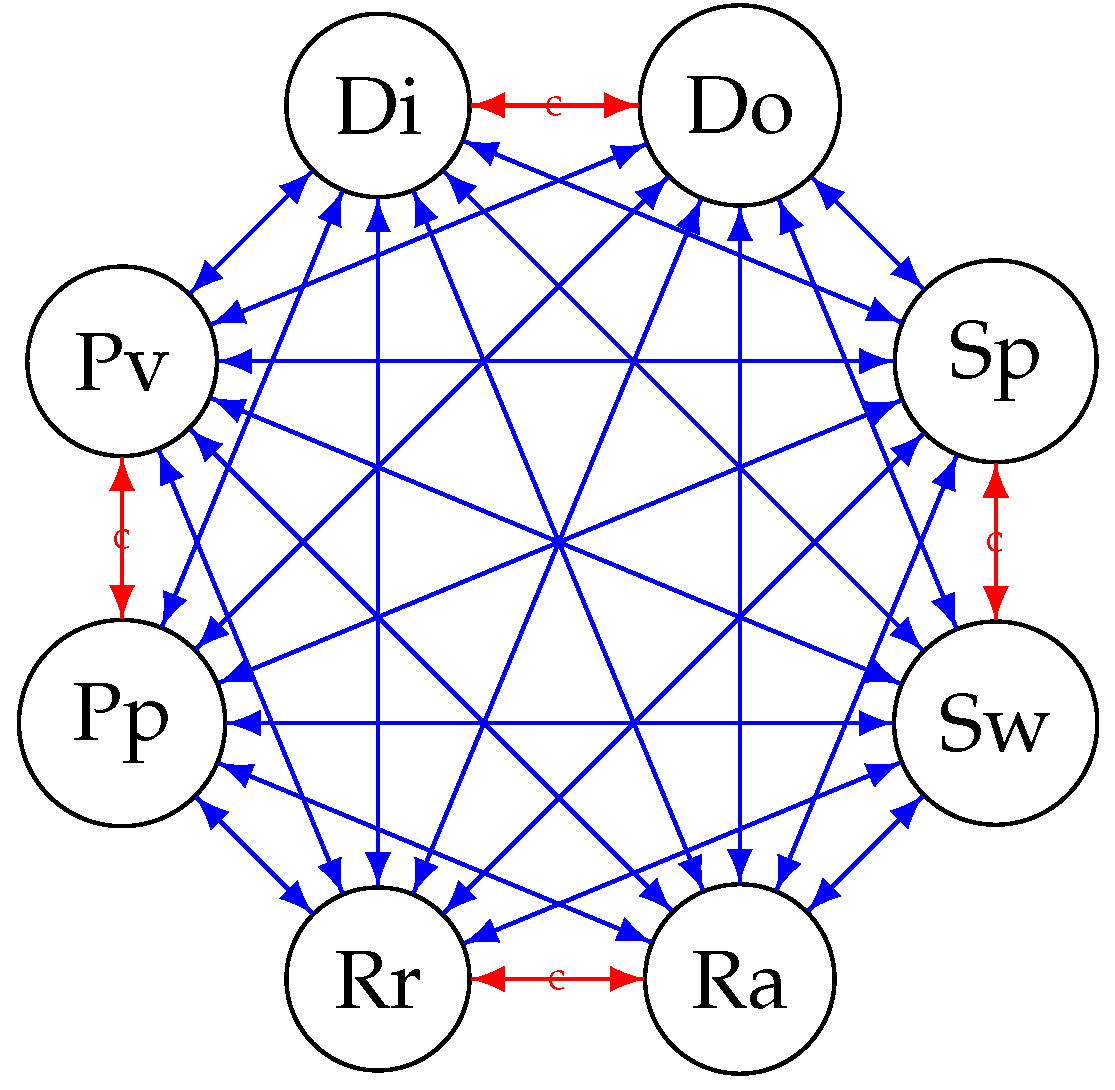
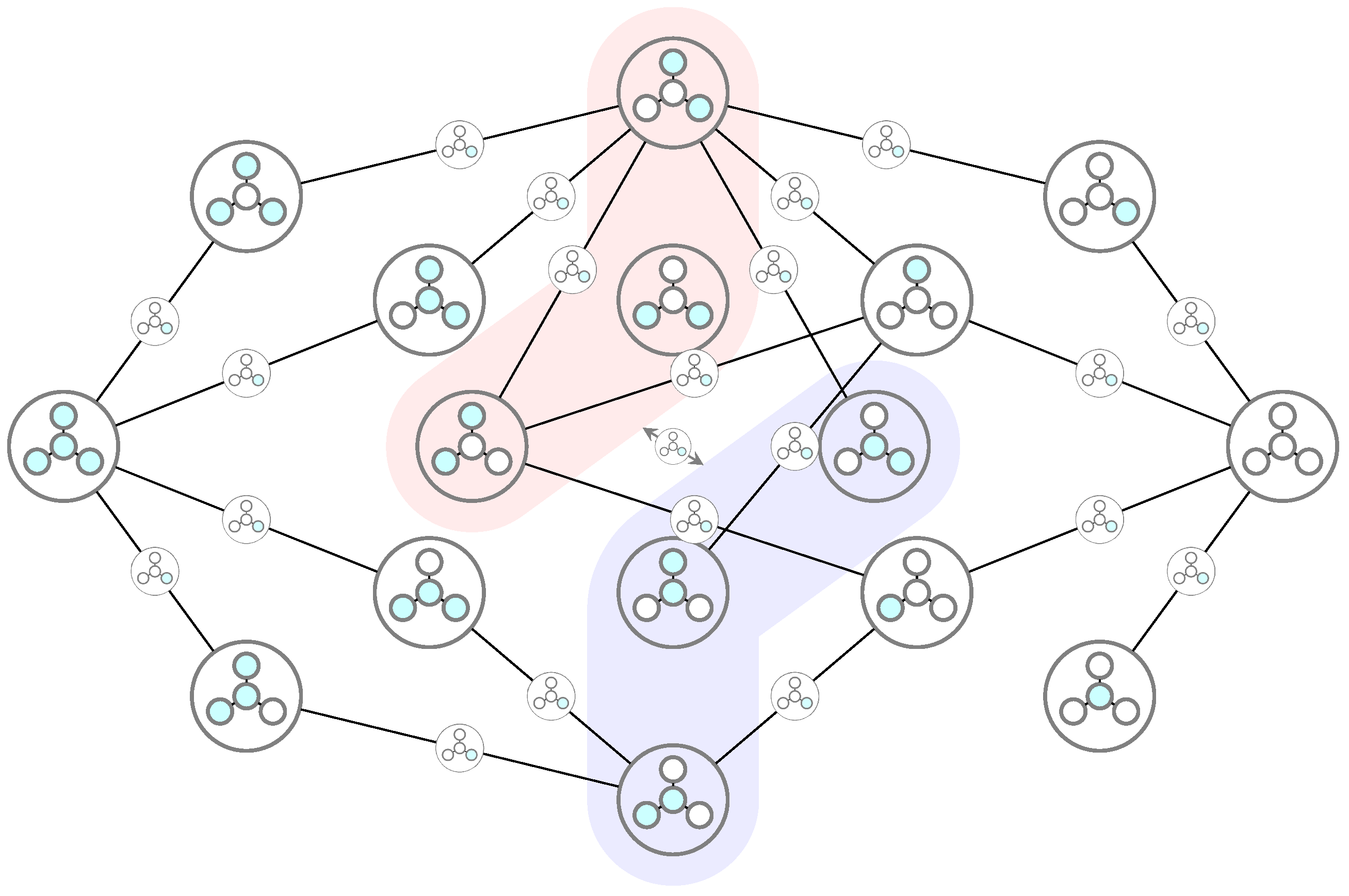
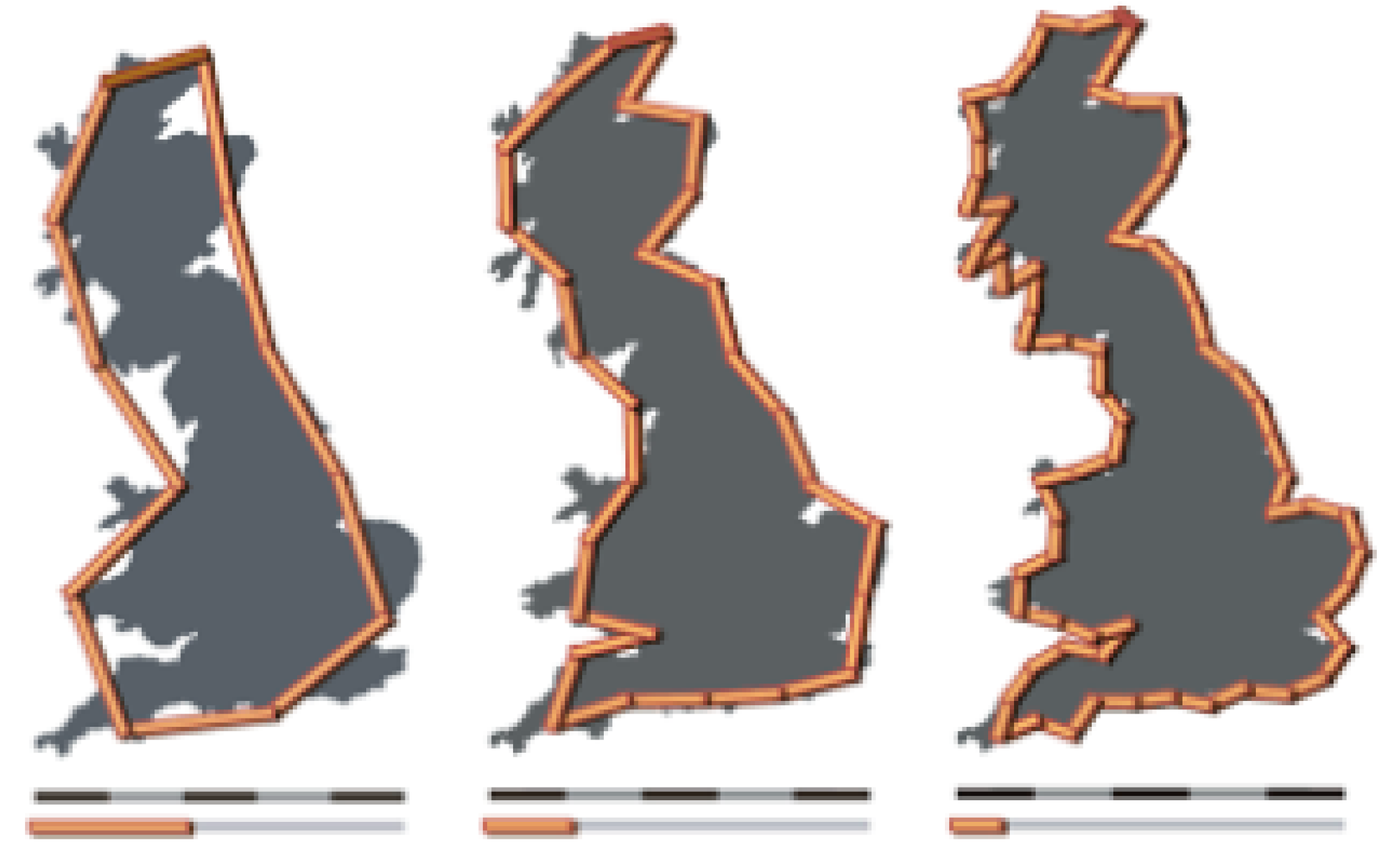
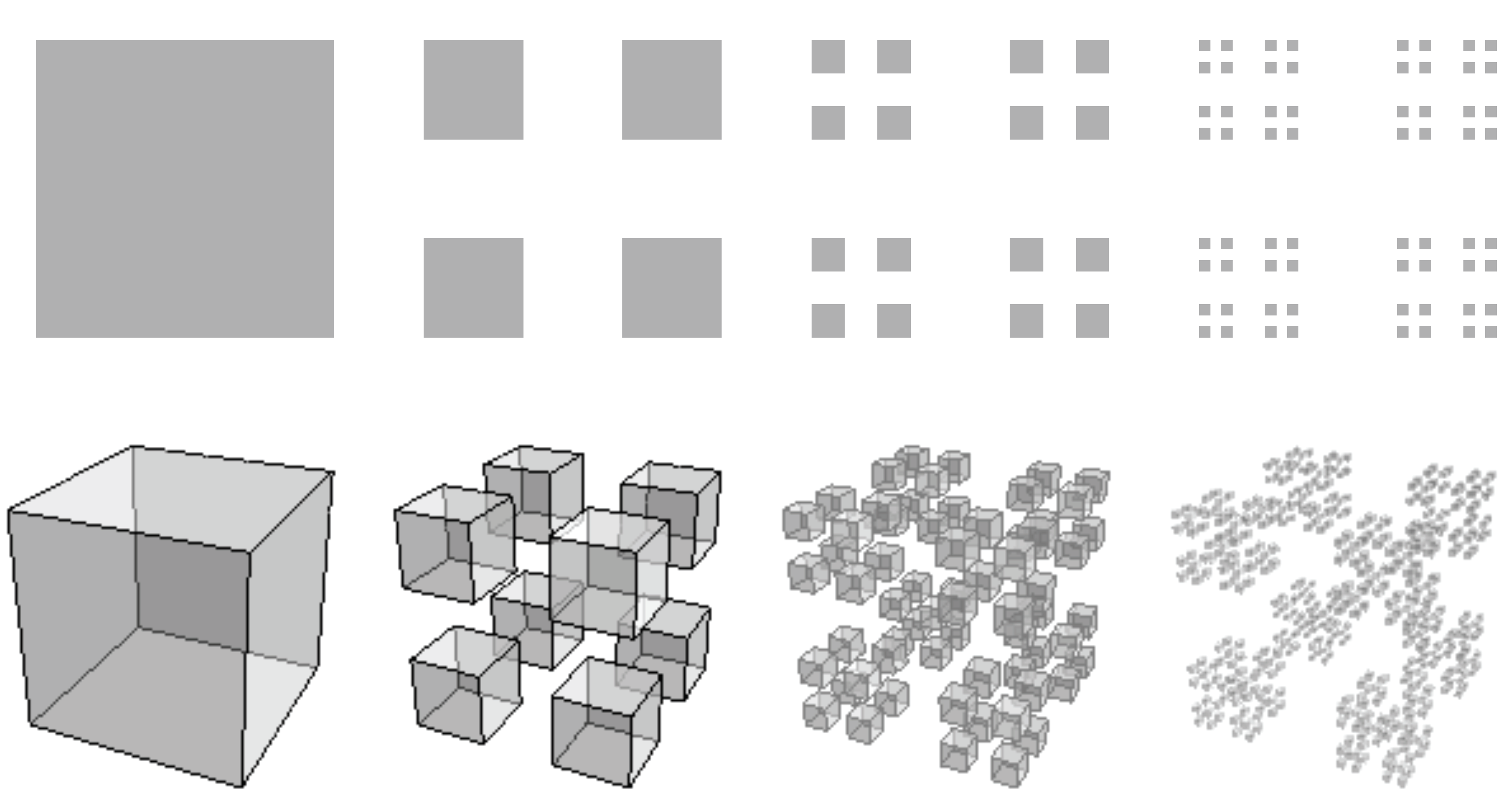
| Mind (cognitive complexity) | Existential (Basic Research) | Efficacy (Applied Research) |
| Does DSRP Exist in Mind? (i.e., Does DSRP exist as universal, material, observable cognitive phenomena?) | Is Metacognitive Awareness of DSRP Effective? (i.e., Does it increase ability to align cognitive complexity to real-world complexity? (a.k.a., parallelism) | |
| Nature (material complexity) | Does DSRP Exist in Nature? (i.e., Does DSRP exist as universal, material, observable phenomena?) | |
| EMPIRICAL BASIS | ||
| Logic Step | Logic | Narrative |
|---|---|---|
| (1) |  | If an identity (i) exists, it implies an other (o). Therefore, Distinctions () exist, universally. |
| (2) |  | If (i) implies (o), and vice versa, then . Therefore, a Relationship () exists, universally. |
| (3) |  | If things are related, a System () exists, universally, where . |
| (4) | 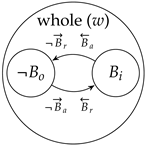 | If (w) is defined by (i), then an alternative system defined by (o) exists and, therefore, a Perspective () exists, universally. |
| (5) | If , then | If the identity A exists (), then is necessary and sufficient. |
| Self Similarity | Necessary and Sufficient |
|---|---|
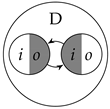 | Any identity–other Distinction is also: (1) Two Distinctions (possible): and ; (2) A Relationship (): ; (3) A System with parts: i, o, and their relationship (); (4) Two Perspectives (possible): i and o. |
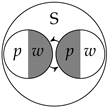 | Any part–whole System is also: (1) Two Distinctions (possible): and ; (2) A Relationship (): ; (3) A System with parts: p, w, and their relationship (); and (4) Two Perspectives (possible): p and w. |
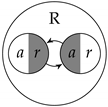 | Any action–reaction Relationship is also: (1) Two Distinctions (possible): and ; (2) A Relationship (): ; (3) A System with parts: a, r, and their relationship (); (4) Two Perspectives (possible): a and r; (5) The Relationship itself is distinct (D), a whole with parts (S), and a Perspective (P). |
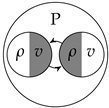 | Any point–view Perspective is also: (1) Two Distinctions (possible): and ; (2) A Relationship (): ; (3) A System with parts: , v, and their relationship (); (4) Two Perspectives (possible): and v. |
| Step | Word Form | Visual Form |
|---|---|---|
| Step 1: Start with some thing (any thing). | What is the identity? (fish) |  |
| Step 2: Predict a structural container and label it with a question mark (?). | Is (fish) a whole (made up of parts)? Is (fish) related to something? |  |
| Step 3: Fill “empty structure” with information you discover (through search, research, observation, etc.) to discover new knowledge (about your topic) based on the universal structure of knowledge and nature. | A fish has parts: fins and gills. Fish are related to plankton. |  |
| Patterns | D | S | R | P |
|---|---|---|---|---|
| D | An S is predictably a D | An R is predictably a D | A P is predictably a D | |
| S | A D is predictably an S | An R is predictably an S | A P is predictably an S | |
| R | A D is predictably an R | An S is predictably an R | A P is predictably an R | |
| P | A D is predictably a P | An S is predictably a P | An R is predictably a P |
| Elements | Identity | Other | Part | Whole | Action | Reaction | Point | View |
|---|---|---|---|---|---|---|---|---|
| identity | An other is predictably an identity | A part is predictably an identity | A whole is predictably an identity | An action is predictably an identity | A reaction is predictably an identity | A point is predictably an identity | A view is predictably an identity | |
| other | An identity is predictably an other | A part is predictably an other | A whole is predictably an other | An action is predictably an other | A reaction is predictably an other | A point is predictably an other | A view is predictably an other | |
| part | An identity is predictably a part | An other is predictably a part | A whole is predictably a part | An action is predictably a part | A reaction is predictably a part | A point is predictably a part | A view is predictably a part | |
| whole | An identity is predictably a whole | An other is predictably a whole | A part is predictably a whole | An action is predictably a whole | A reaction is predictably a whole | A point is predictably a whole | A view is predictably a whole | |
| action | An identity is predictably an action | An other is predictably an action | A part is predictably an action | A whole is predictably an action | A reaction is predictably an action | A point is predictably an action | A view is predictably an action | |
| reaction | An identity is predictably a reaction | An other is predictably a reaction | A part is predictably a reaction | A whole is predictably a reaction | An action is predictably a reaction | A point is predictably a reaction | A view is predictably a reaction | |
| point | An identity is predictably a point | An other is predictably a point | A part is predictably a point | A whole is predictably a point | An action is predictably a point | A reaction is predictably a point | A view is predictably a point | |
| view | An identity is predictably a view | An other is predictably a view | A part is predictably a view | A whole is predictably a view | An action is predictably a view | A reaction is predictably a view | A point is predictably a view |
Publisher’s Note: MDPI stays neutral with regard to jurisdictional claims in published maps and institutional affiliations. |
© 2022 by the authors. Licensee MDPI, Basel, Switzerland. This article is an open access article distributed under the terms and conditions of the Creative Commons Attribution (CC BY) license (https://creativecommons.org/licenses/by/4.0/).
Share and Cite
Cabrera, D.; Cabrera, L. DSRP Theory: A Primer. Systems 2022, 10, 26. https://doi.org/10.3390/systems10020026
Cabrera D, Cabrera L. DSRP Theory: A Primer. Systems. 2022; 10(2):26. https://doi.org/10.3390/systems10020026
Chicago/Turabian StyleCabrera, Derek, and Laura Cabrera. 2022. "DSRP Theory: A Primer" Systems 10, no. 2: 26. https://doi.org/10.3390/systems10020026
APA StyleCabrera, D., & Cabrera, L. (2022). DSRP Theory: A Primer. Systems, 10(2), 26. https://doi.org/10.3390/systems10020026







